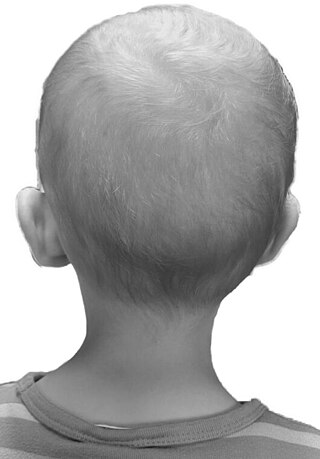
Aniridia is the absence of the iris, a muscular structure that opens and closes the pupil to allow light into the eye. It is also responsible for eye color. Without it, the central eye appears all black. It can be congenital, in which both eyes are usually involved, or caused by a penetrant injury. Isolated aniridia is a congenital disorder that is not limited to a defect in iris development, but is a panocular condition with macular and optic nerve hypoplasia, cataract, and corneal changes. Vision may be severely compromised and the disorder is frequently associated with some ocular complications: nystagmus, amblyopia, buphthalmos, and cataract. Aniridia in some individuals occurs as part of a syndrome, such as WAGR syndrome, or Gillespie syndrome.

Walker–Warburg syndrome (WWS), also called Warburg syndrome, Chemke syndrome, HARD syndrome, Pagon syndrome, cerebroocular dysgenesis (COD) or cerebroocular dysplasia-muscular dystrophy syndrome (COD-MD), is a rare form of autosomal recessive congenital muscular dystrophy. It is associated with brain and eye abnormalities. This condition has a worldwide distribution. Walker-Warburg syndrome is estimated to affect 1 in 60,500 newborns worldwide.

Corneal dystrophy is a group of rare hereditary disorders characterised by bilateral abnormal deposition of substances in the transparent front part of the eye called the cornea.

Laurence–Moon syndrome (LMS) is a rare autosomal recessive genetic disorder associated with retinitis pigmentosa, spastic paraplegia, and mental disabilities.

Cataract-microcornea syndrome is a rare genetic syndrome characterized by congenital cataracts and microcornea in the absence of any other systemic anomaly or dysmorphism. Clinical findings include a reduction in corneal diameter in both meridians in an otherwise normal eye, as well as an inherited cataract, that is primarily bilateral posterior polar with opacification within the lens periphery which advances to form a total cataract after visual maturity is achieved. Other ocular manifestations, such as myopia, iris coloboma, sclerocornea, and Peters anomaly, may be observed.

Hypotrichosis with juvenile macular dystrophy is an extremely rare congenital disease characterized by sparse hair growth (hypotrichosis) from birth and progressive macular corneal dystrophy.

Corneal-cerebellar syndrome is an autosomally recessive disease that was first described in 1985. Three cases are known: all are sisters in the same family.
Autosomal recessive cerebellar ataxia describes a heterogeneous group of rare genetic disorders with an autosomal recessive inheritance pattern and a clinical phenotype involving cerebellar ataxia.

Corneal opacification is a term used when the human cornea loses its transparency. The term corneal opacity is used particularly for the loss of transparency of cornea due to scarring. Transparency of the cornea is dependent on the uniform diameter and the regular spacing and arrangement of the collagen fibrils within the stroma. Alterations in the spacing of collagen fibrils in a variety of conditions including corneal edema, scars, and macular corneal dystrophy is clinically manifested as corneal opacity. The term corneal blindness is commonly used to describe blindness due to corneal opacity.

Cataract-ataxia-deafness syndrome is a very rare genetic disorder which is characterized by mild intellectual disabilities, congenital cataracts, progressive hearing loss, ataxia, peripheral neuropathy, and short height. Only two cases have been reported in medical literature.

Polydactyly-myopia syndrome, also known as Czeizel-Brooser syndrome, is a very rare genetic disorder which is characterized by post-axial polydactyly on all 4 limbs and progressive myopia. Additional symptoms include bilateral congenital inguinal hernia and undescended testes. It has only been described in nine members of a 4-generation Hungarian family in the year 1986. This disorder is inherited in an autosomal dominant manner.
Congenital muscular dystrophy-infantile cataract-hypogonadism syndrome is a very rare genetic disorder which is characterized by congenital muscular dystrophy, infantile-onset cataract, and hypogonadism. Males usually develop Klinefelter syndrome while females develop agenesis of the ovaries. It has been described in eight individuals of which seven came from Finnmark County, Norway. Inheritance pattern is thought to be autosomal recessive.

Amaurosis congenita, cone-rod type, with congenital hypertrichosis is a very rare genetic disorder which is characterized by ocular anomalies and trichomegaly. It is inherited in an autosomal recessive manner. Only 2 cases have been described in medical literature.

Hypomyelination-congenital cataract syndrome is a rare autosomal recessive hereditary disorder that affects the brain's white matter and is characterized by congenital cataract, psychomotor development delays, and moderate intellectual disabilities. It is a type of leukoencephalopathy.

Corneal dystrophy-perceptive deafness syndrome, also known as Harboyan syndrome, is a rare genetic disorder characterized by congenital hereditary corneal dystrophy that occurs alongside progressive hearing loss of post-lingual onset.

Progressive bifocal chorioretinal atrophy, also known for its abbreviations PBCRA or CRAPB, is a rare, slowly progressive, autosomal dominant syndrome characterized by relatively large-sized atrophic hole-shaped lesions in the macular and nasal retina, myopia, low visual acuity, and nystagmus. It has been described in one family from Scotland and two families from France. The condition is caused by point mutations in a region in the long arm of chromosome 6 (6q16.2) that has been found responsible for the pathogenesis of other macular dystrophies.










